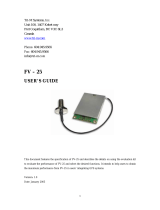
17
The maximum number of fields allowed in a single sentence is 82 characters including delimiters. Values in the
table include the sentence start delimiter character “$” and the termination delimiter <CR><LF>. For the GPS 19x
HVS, the factory set defaults result in a once per second transmission at the NMEA 0183 specification transmission
rate of 4800 baud.
Regardless of the selected baud rate, the information transmitted by the GPS sensor is referenced to the one-pulse-
per-second output pulse immediately preceding the GPRMC sentence, or whichever other sentence is output first in
the burst (see Table 2 above) if RMC sentence is not enabled.
4.2.2 Transmitted Time
The GPS sensor outputs Coordinated Universal Time (UTC) date and time of day in the transmitted sentences. If
sensor is operating at positioning update rate of once per second then time output is of format HHMMSS. If sensor
is operating at a higher positioning update rate then time also contains tenths of a second and is of format
HHMMSS.T .
Before the initial position fix, the on-board clock provides the date and time of day. After the initial position fix, the
date and time of day are calculated using GPS satellite information and are synchronized with the measurement
pulse output.
The GPS sensor uses information obtained from the GPS satellites to add or delete UTC leap seconds and correct the
transmitted date and time of day. The transmitted date and time of day for leap second correction follow the
guidelines in “National Institute of Standards and Technology Special Publication 432 (Revised 1990)” (for sale by
the Superintendent of Documents, U.S. Government Printing Office, Washington, D.C., 20402, U.S.A.).
When a positive leap second is required, one second is inserted at the beginning of the first hour (0h 0m 0s) of the
day that the positive leap is occurring. The minute containing the leap second is 61 seconds long. The GPS sensor
would have transmitted this information for the leap second added December 31, 1998 as follows:
$GPRMC,235959,A,3851.3651,N,09447.9382,W,000.0,221.9,071103,003.3,E*69
$GPRMC,000000,A,3851.3651,N,09447.9382,W,000.0,221.9,081103,003.3,E*67
$GPRMC,000000,A,3851.3651,N,09447.9382,W,000.0,221.9,081103,003.3,E*67
$GPRMC,000001,A,3851.3651,N,09447.9382,W,000.0,221.9,081103,003.3,E*66
If a negative leap second should be required, one second will be deleted at the end of some UTC month. The minute
containing the leap second will be only 59 seconds long. In this case, the GPS sensor will not transmit the time of
day 0h 0m 0s (the “zero” second) for the day from which the leap second is removed.
$GPRMC,235959,A,3851.3650,N,09447.9373,W,000.0,000.0,111103,003.3,E*69
$GPRMC,000001,A,3851.3650,N,09447.9373,W,000.0,000.0,121103,003.3,E*6A
$GPRMC,000002,A,3851.3650,N,09447.9373,W,000.0,000.0,121103,003.3,E*69
4.2.3 Global Positioning System Almanac Data (GPALM)
GPS almanac sentences are normally not transmitted. Send the GPS sensor the sentence “$PGRMO,GPALM,1” to
initiate almanac transmission. Upon receipt, the GPS sensor will transmit available almanac information using
GPALM sentences. During the transmission of almanac sentences, other NMEA 0183 data output is suspended
temporarily.
$GPALM,<1>,<2>,<3>,<4>,<5>,<6>,<7>,<8>,<9>,<10>,<11>,<12>,<13>,<14>,<15>*hh<CR><LF>
<field information> can be found in section 4.1.1 Almanac Information (GPALM).























